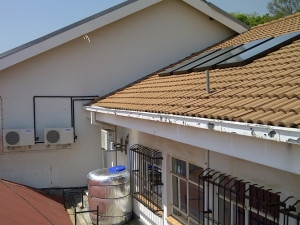
In February 2012, the Zuid Afrikaans Hospital (ZAH), in Mucleneuk, Pretoria, gave Michelangelo Technology the go-ahead to do a comprehensive Green Audit to determine what could be done to save on water and lights consumption. After a thorough consultation process, and presenting the Green Audit report to the board, the General Manager, Tienie van den Berg, contracted Michelangelo in June 2012 to start a Green Economy solution implementation.
"We are committed to improving the infrastructure at the hospital," says Van den Berg." The green approach proposed by Michelangelo can save significantly on our water and lights bill and at the same time reduce our carbon footprint, making Zuid Afrikaans the greenest hospital in the country," he said.
Michelangelo Green Economy entry-level solutions include LED lights, heat pumps with solar pre-heating, inverter air-conditioners, improved insulation, as well as eco-shower heads with rainwater catchment tanks that in combination ensure a payback period of just two years and can help reduce consumption by more than 50%. More advanced Green Economy solutions include building energy and water management with real-time monitoring as well as solar PV renewable energy generation with battery backup to manage peak demand and provide uninterrupted stand-by power until backup generators are online.
"Our Green Economy Business Model makes financial sense," says Michelangelo CEO Andr'e Nel.
"The Michelangelo Green Economy solutions currently being implemented at Zuid Afrikaans Hospital as part of Phase 1 have a projected monthly cost savings on the water and lights bill of +/-R51 532 as from April 2013, with projected electricity savings of 117kVA and 50 494 kWh," he added.
The current Green Economy implementation at ZAH includes 600 LED downlights, 50 LED bulbs, 600 LED tubes and 25 heat pumps with 1 500L of solar hot water pre-heating as well as 45 eco-shower heads (10L/min). It is expected that Phase 1 will be completed by Q4 2013 when a total of +/-2 800 LED tubes will have been retrofitted with 5 500L solar hot water pre-heating in total, set to achieve monthly savings on the water and lights bill of +/-R100 000 with projected electricity savings of 195kVA in peak demand and between 83 000 and 100 000 kWh energy saving per month.
It is anticipated that the Phase 2 Green Economy implementation at ZAH, scheduled for Q3 2013, will include building energy management with real-time monitoring and water conservation, including rainwater catchment tanks, with a target of achieving at least 20% saving on the air-conditioning system and 50% water saving. Furthermore, the Phase 3 design study, starting in January 2013, will determine the feasibility of implementing a 500kVA solar PV solution at ZAH with possible funding from the IDC, supported by Eskom solar PV rebates, with implementation scheduled for 2014. In total, more than 50% savings are achievable on the current water and lights bill at Zuid Afrikaans Hospital with potential savings of at least 25 000 kL of water a year and an annual carbon footprint reduction of approximately 2 600 tons of CO2.
Andr'e Nel was named runner-up "Energy Efficiency Champion" at the 2012 Eskom eta Awards, held on 15 November, for energy-efficient designs completed during 33 Green Audits up to July 2012 and the project implementation at Zuid Afrikaans Hospital that, on completion of the first phase, will save the hospital more than 995 711kWh of energy annually.
Share
Michelangelo Technology
Established in 1999, Michelangelo Technology has been developing energy-efficient solutions for the last seven years. Exports into Africa have placed the company in a position to fund the in-house development of energy-efficient, theft-proof computers as well as solutions for green buildings. Today, the Michelangelo Green Economy business model offers energy-efficient water heating and lighting as well as air-conditioning along with water conservation, and includes electronic metering for electricity and water usage. Its Green Economy solutions are feasible in almost all cases and are scalable to include residential, hospitality, educational, commercial and industrial markets. Future research and development efforts into hybrid energy solutions incorporating various solar technologies will be undertaken in collaboration with the University of North West as part of a NRF THRIP grant. Visit www.michelangelotech.co.za.
Editorial contacts